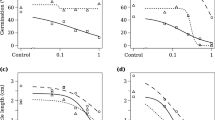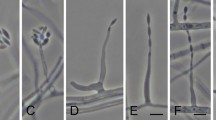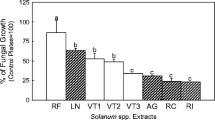Abstract
The known compounds friedelin, maytensifolin B, ginkgetin, bilobetin, and amentoflavone as well as the new triterpene 3β-hydroxyfriedelan-16-one were isolated fromCelaenodendron mexicanum (Euphorbiaceae), an endemic tree of the Pacific Ocean coast of Mexico. The compounds' structures were established on the basis of spectral analysis. The biological effects of aqueous leachates, a CHCl3-MeOH extract and the isolated compounds of leaves and twigs were evaluated on the radicle growth of two plants,Amaranthus leucocarpus andEchinochloa crusgalli, and on the radial growth of three phytopathogenic fungi,Fusarium sp.,Helminthosporium sp., andAlternaria sp. The organic extracts of both leaves and twigs inhibitedAmaranthus and stimulatedEchinochloa radicle growth. On the contrary, friedelin and maytensifolin B stimulatedAmaranthus and inhibitedEchinochloa. The target fungi showed a different response to each treatment, from inhibition to stimulation.
Similar content being viewed by others
References
Anaya, A.L., andRovalo, M. 1976. Alelopatía en plantas superiores: Diferencias entre el efecto de la presión osmótica y los alelopáticos sobre la germinatión y el crecimiento de algunas especies de la vegetatión secundaria de una zona cálido-húmeda de México, pp. 388–427,in A. Butanda (eds.). Investigaciones sobre la Regeneratión de Selvas en Veracruz, México. Co. Ed. Continental, S.A. México.
Anaya, A.L., Ramos, L., Hernández, J.G., andCruz, R. 1987. Allelopathy in México,in G.R. Waller (ed.) Allelochemicals: Role in agriculture and forestry.ACS Symp. Ser. 330:89–101.
Baker, W.,Finch, A.C.M.,Ollis, W.D., andRobinson, K.W. 1963. The structures of the naturally occurring biflavonyls.J. Chem. Soc. 1477–1490.
Borner, H. 1959. The apple replant problem. I. The excretion of phlorizin from apple root residues.Contrib. Boyce Thompson Inst. 20:39–56.
Corcuera, L.J.,Argando¯na, V.H., andZu¯niga, G.E. 1987. Resistance of cereal crops to aphids: role of allelochemicals, pp. 129–135;in Waller, G.R. (ed.). Allelochemicals: Role in agriculture and forestry.ACS Symp. Ser. 330:129–135.
Courtney, J.L., andShannon, J.S. 1963. Studies in mass spectrometry triterpenoids: Structure assignment to some friedelane derivates.Tetrahedron Lett. 1:13–20.
Chari, V.M., Ilyas, M., Wagner, H., Nezmelyi, A., Chen, F.C., Chen, L.K., Lin, Y.C., andLin, M.Y. 1977.13C NMR Spectroscopy of biflavonoids.Phytochemistry 16:1273–1278.
Del Amo, R.S., andAnaya, A.L. 1978. Effect of some sesquiterpenic lactones on the growth of certain secondary tropical species.J. Chem. Ecol. 4:305–313.
Ferris, R. 1927. Preliminary report on the flora of the Tres Marias Islands.Contrib. Dudley Herbar. Stanford Univ. 1:63–81.
Filip, V., Dirzo, R.,Maass, M., andSarukhán, J. 1992. Levels of hervibore damage on the foliage of trees from a tropical deciduous forest in West Mexico (in press).
Fottrell, P.F., O'Connor, S., andMasterson, C.L. 1964. Identification of the flavonol myricetin in legume seeds and its toxicity to nodule bacteria.J. Agr. Res. 3:246–249.
Garg, H.S., andMitra, C.R. 1971. Putraflavone, a new biftavonoid fromPutranjiva roxburghii.Phytochemistry 10:2787–2791.
Gonzalez de la Parra M., Anaya, A.L., Espinoza, F., Jiménez, M., andCastillo, R., 1981. Allelopathic potential ofPiqueria trinervia (Compositae) and piquerais A and B.J. Chem. Ecol. 7:405–416.
Gunatilaka, L., Nanayakkara, D., andWazeer, M. 1983.13C NMR spectra of some D: A friedo-oleananes.Phytochemistry 22:991–992.
Horhammer, L., Wagner, H., andReinhardt, H. 1965. Isoleuring des Bis-(5,7,4 -trihydroxy-)-flavons, Amentoflavon aus der Rinde vonViburnum prunifolium L. (Amerikan Schneeball).Naturwissenschaften 7:161–162.
Joly, M., Haag-Berrurier, M., andAnton, R., 1980. La 5′ -methoxybilobetine, une biflavone extraite duGinkgo biloba.Phytochemistry 19:1999–2002.
Kikuchi, T., Shingu, T., Niwa, M., andYokoi, T. 1973a. Application of homonuclear INDOR spectroscopy in friedelin type triterpenes.Chem. Pharm. Bull. 21(6): 1396–1397.
Kikuchi, T., Talayama, M., Toyoda, T., Arimoto, M., andNiwa, M. 1973b. Studies on the neutral constituents ofPachisandra terminalis Sieb, et Zucc V. Structures of Pachysandiol-B and Pachysonol, New friedelin type triterpenes.Chem. Pharm. Bull. 21(10):2243–2251.
Lodhi, M.A.K., andKillingbeck, K.T. 1980. Allelopathic inhibition of nitrification and nitrifying bacteria in a ponderosa pine (Pinus ponderosa Dougl) community.Am. J. Bot. 67:1423–1429.
Mandava, B.N. 1985. Chemistry and biology of allelopathic agents,in Thompson, A.C. (ed.). The Chemistry of Allelopathy: Biochemical Interactions Among Plants.ACS Symp. Ser. 268: 33–54.
Moreland, G.D., andNovitzky, W.P. 1987. Effects of phenolic acids, coumarins and flavonoids on isolated chloroplasts and mitochondria,in Waller, G.R. (ed.). Allelochemicals: Role in Agriculture and Forestry.ACS Symp. Ser. 330:247–261.
Muller, C.H., andDel Moral, R. 1966. Soil toxicity induced by terpenes fromSalvia leucophylla.Bull. Torrey Bot. Club 93:130–137.
Nosaki, H., Suzuki, H., Hirayama, T., Kasai, R., Wu, R.Y., andLee, K.H. 1986. Antitumor triterpenes ofMaytenus diversifolia.Phytochemistry 25(2):479–485.
Patra, A., andKumar, S. 1987. Assignment of carbon-13 nuclear magnetic resonance spectra of some friedelanes.Magnet. Reson. Chem. 25:95–100.
Peeter, A., Warren, R., Chexal, K.K., Handa, B.K., andRahman, W. 1971. Biflavonyls from GuttiferaeGarcinia livingstonnii.Tetrahedron 27:1625–1634.
Rice, E.L. 1984. Allelopathy. Academic Press, London.
Rice, E.L., andPancholy, S.K. 1973. Inhibition of nitrification by climax ecosystems. II. Additional evidence and possible role of tannins.Am. J. Bot. 60:691–702.
Rice, E.L., andPancholy, S.K. 1974. Inhibition of nitrification by climax ecosystems. III. Inhibitors other than tannins.Am. J. Bot. 61:1095–1103.
Robinson, T. 1983. The Organic Constituents of Higher Plants. Cordus Press, North Amherst, MA.
Shannon, J.S., McDonald, C.G., andCourtney, J.L. 1963. Studies in mass spectrometry triterpenoids: Structure assignment to friedelan-γ-one (γ-al) and derivates.Tetrahedron Lett. 4:173–179.
Spencer, K.C. 1987. Specificity of action of allelochemicals: Diversification of glycosides,in Waller, G.R. (ed.). Allelochemicals: Role in Agriculture and Forestry.ACS Symp. Ser. 330:275–288.
Varshney, A.K., Rahman, W., andOkigawa, M. 1973. Robustaflavone the first member of a new series of biflavones.Experientia 29(7):784–786.
Williams, A.H. 1960. The distribution of phenolic compounds in apple and pear trees, pp. 3–7,in Bridham, J.B. (ed.). Phenolics in Plants in Health and Dissease. Pergamon, New York.
Author information
Authors and Affiliations
Additional information
Taken in part from the M.Sc. thesis of P. Castañeda.
On sabbatical leave from Departamento de Preparatoria Agrícola Universidad Autónoma de Chapingo, México.
Rights and permissions
About this article
Cite this article
Castañeda, P., Garcia, M.R., Hernandez, B.E. et al. Effects of some compounds isolated fromCelaenodendron mexicanum standl (euphorbiaceae) on seeds and phytopathogenic fungi. J Chem Ecol 18, 1025–1037 (1992). https://doi.org/10.1007/BF00980060
Received:
Accepted:
Issue Date:
DOI: https://doi.org/10.1007/BF00980060




